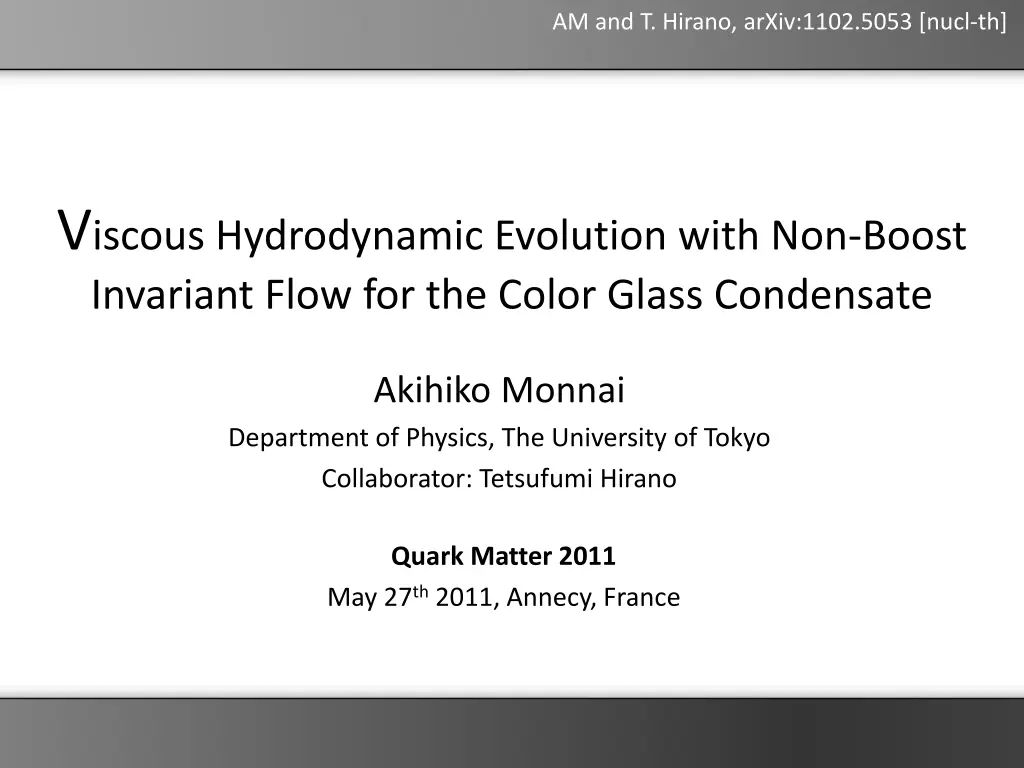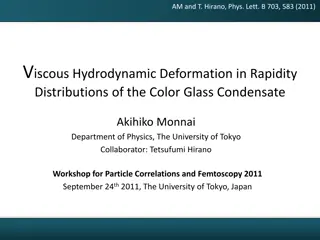
Viscous Hydrodynamic Evolution in Heavy Ion Collisions
Explore the viscous hydrodynamic evolution with non-boost invariant flow for the Color Glass Condensate in high-energy heavy ion collisions. Discuss the Quark-Gluon Plasma (QGP), hadronic phase, and modeling techniques. Dive into the results from RHIC and LHC experiments, and the implications for future research in the field of nuclear theory.
Download Presentation

Please find below an Image/Link to download the presentation.
The content on the website is provided AS IS for your information and personal use only. It may not be sold, licensed, or shared on other websites without obtaining consent from the author. If you encounter any issues during the download, it is possible that the publisher has removed the file from their server.
You are allowed to download the files provided on this website for personal or commercial use, subject to the condition that they are used lawfully. All files are the property of their respective owners.
The content on the website is provided AS IS for your information and personal use only. It may not be sold, licensed, or shared on other websites without obtaining consent from the author.
E N D
Presentation Transcript
AM and T. Hirano, arXiv:1102.5053 [nucl-th] Viscous Hydrodynamic Evolution with Non-Boost Invariant Flow for the Color Glass Condensate Akihiko Monnai Department of Physics, The University of Tokyo Collaborator: Tetsufumi Hirano Quark Matter 2011 May 27th2011, Annecy, France
Akihiko Monnai (The University of Tokyo) Viscous Hydrodynamic Evolution with Non-Boost Invariant Flow for the Color Glass Condensate Introduction Quark-gluon plasma (QGP) at relativistic heavy ion collisions Hadron phase (crossover) QGP phase sQGP (wQGP?) RHIC experiments (2000-) The QGP quantified as a nearly-perfect fluid Viscosity is important for improved inputs (initial conditions, equation of state, etc.) Consistent modeling is necessary to extract physical properties from experimental data / 12 2 Next slide: Quark Matter 2011, May 27, Annecy, France Introduction
Akihiko Monnai (The University of Tokyo) Viscous Hydrodynamic Evolution with Non-Boost Invariant Flow for the Color Glass Condensate Introduction Modeling a high-energy heavy ion collision particles t Freezeout Hadronic cascade Hydro to particles Hydrodynamic stage QGP phase hadronic phase Pre- equilibrium Initial condition Color glass condensate z Color glass condensate (CGC) Description of saturated gluons in the nuclei before a collision ( < 0 fm/c) Relativistic hydrodynamics Description of collective motion of the QGP ( ~ 1-10 fm/c) / 12 3 Next slide: Quark Matter 2011, May 27, Annecy, France First Results from LHC
Akihiko Monnai (The University of Tokyo) Viscous Hydrodynamic Evolution with Non-Boost Invariant Flow for the Color Glass Condensate First Results from LHC LHC experiments (2010-) Heavy ion collisions of higher energies Will the RHIC modeling of heavy ion collisions be working intact at LHC? Mid-rapidity multiplicity Pb+Pb, 2.76 TeV at = 0 K. Aamodt et al. PRL105 252301 ALICE data (most central 0-5%) CGC CGC; fit to RHIC data but no longer valid at LHC? / 12 4 Next slide: Quark Matter 2011, May 27, Annecy, France CGC in Heavy Ion Collisions
Akihiko Monnai (The University of Tokyo) Viscous Hydrodynamic Evolution with Non-Boost Invariant Flow for the Color Glass Condensate CGC in Heavy Ion Collisions Saturation scale in MC-KLN model D. Kharzeev et al., NPA 730, 448 =0.38 =0.28 =0.18 Fixed via direct comparison with data dNch/d gets steeper with increasing ; RHIC data suggest ~0.28 dN/dy CGC + Hydrodynamic Model Initial condition from the CGC Observed particle distribution Initial condition from the CGC Hydrodynamic evolution Observed particle distribution a missing piece! We need to estimate hydrodynamic effects with (i) non-boost invariant expansion (ii) viscous corrections for the CGC / 12 5 Next slide: Quark Matter 2011, May 27, Annecy, France Hydrodynamic Model
Akihiko Monnai (The University of Tokyo) Viscous Hydrodynamic Evolution with Non-Boost Invariant Flow for the Color Glass Condensate Hydrodynamic Model Decomposition of the energy-momentum tensor by flow where is the projection operator 2 equilibrium quantities 10 dissipative currents Energy density: Hydrostatic pressure: Energy density deviation: Bulk pressure: Energy current: Shear stress tensor: related in equation of state Stability condition + frame fixing Thermodynamic stability demands This leaves and Identify the flow as local energy flux / 12 6 Next slide: Quark Matter 2011, May 27, Annecy, France Hydrodynamic model
Akihiko Monnai (The University of Tokyo) Viscous Hydrodynamic Evolution with Non-Boost Invariant Flow for the Color Glass Condensate Hydrodynamic Model Full 2ndorder viscous hydrodynamic equations + AM and T. Hirano, NPA 847, 283 Energy-momentum conservation EoM for bulk pressure EoM for shear tensor All the terms are kept Solve in (1+1)-D relativistic coordinates (= no transverse flow) with piecewise parabolic + iterative method Note: (2+1)-D viscous hydro assumes boost-invariant flow / 12 7 Next slide: Quark Matter 2011, May 27, Annecy, France Model Input for Hydro
Akihiko Monnai (The University of Tokyo) Viscous Hydrodynamic Evolution with Non-Boost Invariant Flow for the Color Glass Condensate Model Input for Hydro Equation of state and transport coefficients S. Borsanyi et al., JHEP 1011, 077 Equation of State: Lattice QCD P. Kovtun et al., PRL 94, 111601 A. Hosoya et al., AP 154, 229 Shear viscosity: = s/4 Bulk viscosity: eff= (5/2)[(1/3) cs2] AM and T. Hirano, NPA 847, 283 Relaxation times: Kinetic theory & , 2ndorder coefficients: Kinetic theory & , Initial conditions Initial flow: Bjorken flow (i.e. flow rapidity Yf= s) H. J. Drescher and Y. Nara, PRC 75, 034905; 76, 041903 Energy distribution: MC-KLN type CGC model Dissipative currents: T = 0 Initial time: = 1 fm/c / 12 8 Next slide: Quark Matter 2011, May 27, Annecy, France Results
Akihiko Monnai (The University of Tokyo) Viscous Hydrodynamic Evolution with Non-Boost Invariant Flow for the Color Glass Condensate Results CGC initial distributions + longitudinal viscous hydro LHC RHIC Outward entropy flux Entropy production Flattening Enhancement If the true is larger at RHIC, it enhances dN/dy at LHC; Hydro effect is a candidate for explaining the gap at LHC / 12 9 Next slide: Quark Matter 2011, May 27, Annecy, France Results
Akihiko Monnai (The University of Tokyo) Viscous Hydrodynamic Evolution with Non-Boost Invariant Flow for the Color Glass Condensate Results Flow rapidity: Deviation from boost-invariant flow RHIC LHC = 30 fm/c = 50 fm/c The systems are far from boost invariant at RHIC and LHC Ideal flow viscous flow due to competition between deceleration by suppression of total pressure P0 + at early stage and acceleration by enhancement of hydrostatic pressure P0at late stage / 12 10 Next slide: Quark Matter 2011, May 27, Annecy, France Summary and Outlook
Akihiko Monnai (The University of Tokyo) Viscous Hydrodynamic Evolution with Non-Boost Invariant Flow for the Color Glass Condensate Summary and Outlook We solved full 2ndorder viscous hydro in (1+1)-dimensions for the shattered color glass condensate Non-trivial deformation of CGC rapidity distribution due to (i) outward entropy flux (non-boost invariant effect) (ii) entropy production (viscous effect) Viscous hydrodynamic effect may play an important role in understanding the seemingly large multiplicity at LHC Future prospect includes: AM & T. Hirano, in preparation Detailed analyses on parameter dependences, rcBK, etc A (3+1)-dimensional viscous hydrodynamic model, etc / 12 11 Next slide: Quark Matter 2011, May 27, Annecy, France The End
Akihiko Monnai (The University of Tokyo) Viscous Hydrodynamic Evolution with Non-Boost Invariant Flow for the Color Glass Condensate The End Thank you for listening! Website: http://tkynt2.phys.s.u-tokyo.ac.jp/~monnai/index.html / 12 12 Next slide: Quark Matter 2011, May 27, Annecy, France Appendices
Akihiko Monnai (The University of Tokyo) Viscous Hydrodynamic Evolution with Non-Boost Invariant Flow for the Color Glass Condensate Results Parameter dependences (i) /s = 0, eff/s = 0 (ii) /s = 1/4 , eff/s = (5/2)[(1/3) cs2]/4 (iii) /s = 3/4 , eff/s = (15/2)[(1/3) cs2]/4 Larger entropy production for more viscous systems preliminary Comparison to boost-invariant flow Longitudinal viscous hydro expansion is essential / 12 13 Next slide: Quark Matter 2011, May 27, Annecy, France Appendices
Akihiko Monnai (The University of Tokyo) Viscous Hydrodynamic Evolution with Non-Boost Invariant Flow for the Color Glass Condensate Results Time evolution for LHC settings Rapidity distribution: no sizable modification after 20 fm/c It can be accidental; needs further investigation on parameter dependence Flow rapidity: visible change even after 20 fm/c Rise-and-dip at 5 fm/c is due to reduction in effective pressure P0 + / 12 14 Next slide: Quark Matter 2011, May 27, Annecy, France Appendices
Akihiko Monnai (The University of Tokyo) Viscous Hydrodynamic Evolution with Non-Boost Invariant Flow for the Color Glass Condensate Thermodynamic Stability Maximum entropy state condition - Stability condition (1storder) - Stability condition (2ndorder) automatically satisfied in kinetic theory *Stability conditions are NOT the same as the law of increasing entropy / 12 15 Next slide: Quark Matter 2011, May 27, Annecy, France Appendices
Akihiko Monnai (The University of Tokyo) Viscous Hydrodynamic Evolution with Non-Boost Invariant Flow for the Color Glass Condensate Introduction Properties of the QCD matter Equation of state: relation among thermodynamic variables sensitive to degrees of freedom in the system Transport coefficients: responses to thermodynamic forces sensitive to interaction in the system Na ve interpretation of dissipative processes Shear viscosity = response to deformation Bulk viscosity = response to expansion Energy dissipation = response to thermal gradient Charge dissipation = response to chemical gradients / 12 16 Next slide: Quark Matter 2011, May 27, Annecy, France Appendices
Akihiko Monnai (The University of Tokyo) Viscous Hydrodynamic Evolution with Non-Boost Invariant Flow for the Color Glass Condensate Introduction Geometrical setup of colliding nuclei x y z x Longitudinal expansion Transverse plane Relativistic coordinates Transverse mass: Proper time: Space-time rapidity: Rapidity: Centrality Determined by groups (20-30%, etc.) of events per number of participants / 12 17 Next slide: Quark Matter 2011, May 27, Annecy, France Appendices

